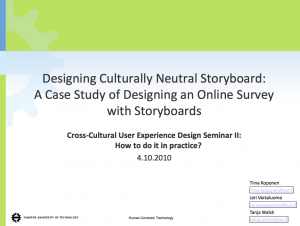In Module 1, we’ve examined whether or not technology is culturally neutral. Our readings and interactions thus far have indicated it is not. I have discovered online a case study by the Tampere University of Technology which examines the design of an online survey using what is described as a “culturally neutral storyboard.” Many of the questions related to social networking services. While not explicitly related to aboriginal education, I thought this tied in nicely with our module one discussion on the cultural neutrality of technology, particularly since it was using storyboards as a vehicle. Aboriginal history, being based on an oral tradition, I believe can likely identify more with storyboarding as their history is, indeed, based on a series of stories. It was interesting to note in this study the different reactions different cultural groups would give to certain storyboard images. For example, Indian respondents interpreted a bunch of friends on a beach to be a family gathering, whereas other cultural groups may interpret the gathering differently. The results of the study identified a few main findings, including the fact that storyboards helped respondents to understand difficult concept ideas and imagine themselves into the use situations, which made answering to the social networking services questions easier and fun. In addition, the storyboards themselves were well understood by users with different cultural backgrounds. The case study presentation can be found online here.
Tag Archives: Culturally Neutral
Aiming for Culturally Neutral ET (Allen Module 1 #1)
In Module 1, we were asked to consider whether or not technology is culturally neutral. My observations at this early stage suggest it is not. That’s not to say it cannot get there eventually or at least get closer.
Educational technology can get closer by embracing forms of inclusivity and including cultural variables. An article in the Australian Journal of Educational Technology (McLoughan & Oliver, 2000), provides design suggestions that include emphasis on flexibility and authenticity as well as variances for individualized learning goals and assessment tools.
On a more practical level, the Government of Queensland Dept. of Education Productive Pedagogies website provides a Classroom Reflection Manual with several concrete examples to ensure “recognition and value of differences” in learning activities.
The site identifies 5 important considerations that help teachers recognize and value difference.
- Cultural Knowledge
- Inclusivity
- Narrative
- Group Identity
- Active Citizenship
Suggestions include having students decide what conceptualizations are most relevant to them in the context of their identity and surroundings. One example provided involves having students select and choose appropriate clip-art representations for a class Mother’s Day project. While this site is aimed at elementary educators, it appears to have application in secondary, post secondary, and informal adult learning environments.
